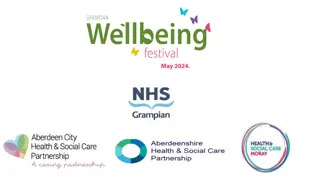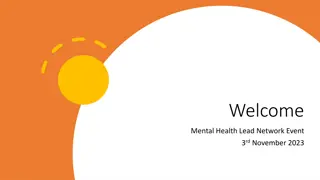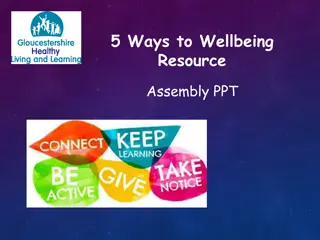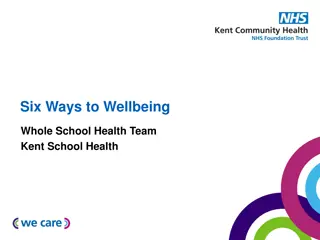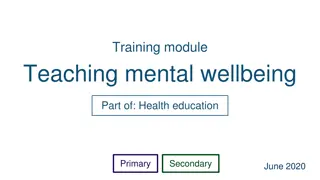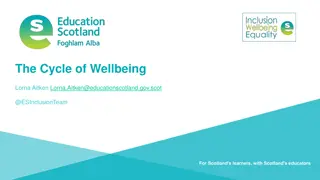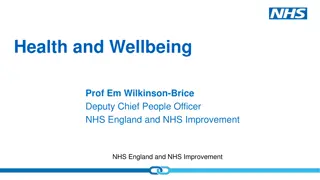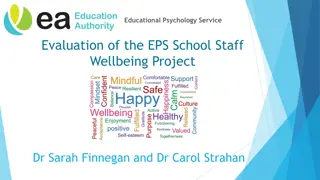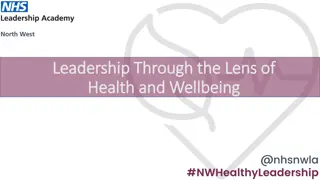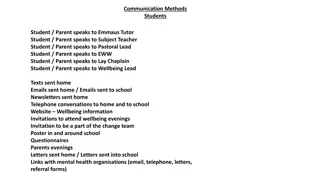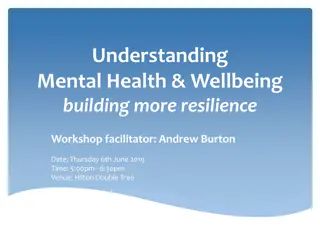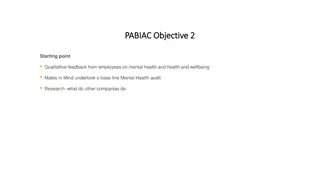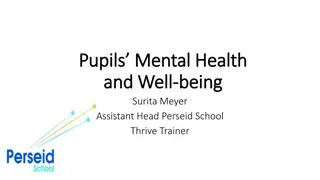Understanding Mental Health: Insights and Tips for Wellbeing
Mental health is crucial for overall well-being, affecting how we feel, think, and act. Dr. Kumaran Gohula Thevan, a Consultant Child & Adolescent Psychiatrist, emphasizes the importance of addressing mental health issues early. The definition, characteristics of good and poor mental health, and the mental health continuum are discussed, highlighting the need to seek help when necessary. The article also provides insights into promoting good mental health and identifies 8 ways to enhance well-being, including communication, exercise, and self-care practices.
Download Presentation

Please find below an Image/Link to download the presentation.
The content on the website is provided AS IS for your information and personal use only. It may not be sold, licensed, or shared on other websites without obtaining consent from the author. Download presentation by click this link. If you encounter any issues during the download, it is possible that the publisher has removed the file from their server.
E N D
Presentation Transcript
Section Title Mental Health Dr Kumaran Gohula Thevan Consultant Child & Adolescent Psychiatrist Named Doctor for Safeguarding
Mental Health All of us have mental health and, like our bodies, our minds can become unwell. 1 in 10 young people will experience a mental health problem. These include depression, anxiety disorder, eating disorders, psychosis or bipolar disorder. A mental health problem can feel just as bad, or worse, as any other physical illness only you cannot see it. It s important to talk about mental health and get help early if things don t feel right, just like we would for our physical health.
Definition of mental health "The capacity to live a full, productive life as well as the flexibility to deal with its ups and downs. In children and young people it is especially about the capacity to learn, enjoy friendships, to meet challenges, to develop talents and capabilities. Source: Young Minds 1999
Characteristics of good mental health Feels good about themselves Uses health skills Stress management Decision making Conflict resolution Uses I messages Feels comfortable with other people Able to meet the demands of life Copes/adapts with change Assertive Expresses emotions in healthy ways Active listener Is optimistic (positive) Can be part of a team/group
Characteristics of poor mental health Does NOT share feelings You messages (blame and escalate) Emotions control behaviors Aggressive and passive Is pessimistic (negative) Depressed Ignores/denies problems Can not accept change Runs from conflict Close minded Lets stress control life Needs to run the group
The mental health continuum Good wellbeing Mental Wellbeing I have a mental health diagnosis but I am coping well and enjoying my life I have no diagnosis. I am well and enjoying my life I have a mental health diagnosis but I am not coping and I am not happy I have no diagnosis, but I am not coping and I am not happy Poor wellbeing
Section Title 8 Ways to Wellbeing Talking being open with people I trust about how I m feeling. Exercising looking after my body, playing sport, eating healthy. Calming trying meditation, good sleep habits like turning my phone off early. Learning a new skill, a great way to gain confidence. Relating spending time with the people I care about. Contributing helping others or contributing to causes I believe in. Creating expressing myself creatively e.g. music, art, drama, writing. Congratulating being kind to myself, or listing the qualities I value in myself.
Time to Change Time to Change is a nationwide movement to get people talking about mental health. No one should feel ashamed about having a mental health problem, they wouldn t if they had a broken leg. Today we re going to learn a bit more about mental health and challenge some of the common myths
Cultural perspectives on mental health problems Different cultures have different approaches to mental health and mental illness. Most Western countries agree on a similar set of clinical diagnoses and treatments for mental health problems. However, cultures in which there are other traditions or beliefs may not use these terms. Depending on the culture you grew up in, you might be more familiar with terms related to mental illness. And in many cultures, mental health is closely associated with religious or spiritual life. How you understand your own mental health, and any problems you experience, will be personal to you.
Experiencing Mental Illness Experiencing a mental health problem is often upsetting and frightening, particularly at first. Being unwell may feel that it's a sign of weakness, or that you are 'losing your mind', and that it's only going to get worse. You may be scared of being seen as 'mad' by other people in your life. You may also be afraid of being locked up in an institution. These fears are often reinforced by the negative portrayals. Evidence shows this stops young people from talking about problems, or seeking help. .
Negative Portrayals of Mental Illness The majority of violent crimes and homicides are committed by people who do not have mental health problems. People with mental health problems are more dangerous to themselves than they are to others: 90% of people who die through suicide in the UK are experiencing mental distress. It is estimated that more than 7 million people will have a mental illness. 50 70 cases of homicide a year involving people known to have a mental health problem Contrary to popular belief, the incidence of homicide committed by people diagnosed with mental health problems has stayed at a fairly constant level since the 1990s Substance abuse appears to play a role: The prevalence of violence is higher among people who have symptoms of substance abuse (including discharged psychiatric patients and non-patients).
Types of Mental Illness There are many different mental health problems, and many symptoms are common to more than one diagnosis.. Common Symptoms include: Low mood Self-harm Anxiety and Panic Aggression Inability to function Poor concentration Poor sleep Poor appetite Paranoia
Major Mental Illnesses Schizophrenia Bipolar Disorder Major Depression Obsessive-Compulsive Disorder Anxiety/Panic Disorder
Neurodevelopmental Disorders Learning Disability ADHD ASD Dyslexia Dyspraxia OCD Tourettes Epilepsy
Classification and Diagnosis of Childhood Disorders Externalizing disorders Characterized by outward-directed behaviors Noncompliance, aggressiveness, overactivity, impulsiveness Includes attention-deficit/hyperactivity disorder, conduct disorder, and oppositional defiant disorder. More common in boys Internalizing disorders Characterized by inward-focused behaviors Depression, anxiety, social withdrawal Includes childhood anxiety and mood disorders More common in girls
Attention Deficit/Hyperactivity Disorder Excessive levels of activity Fidgeting, squirming, running around when inappropriate, incessant talking Distractibility and difficulty concentrating Makes careless mistakes, cannot follow instructions, forgetful
Attention Deficit/Hyperactivity Disorder Three subcategories in DSM-IV-TR 1. Predominantly inattentive type 2. Predominantly hyperactive-impulsive type 3. Combined type Differential diagnosis ADHD or Conduct Disorder? ADHD More off-task behavior, cognitive and achievement deficits Conduct Disorder More aggressive, act out in most settings, antisocial parents, family hostility
Girls with Attention Deficit/Hyperactivity Disorder Hinshaw et al. (2006) large, ethnically diverse study of girls Combined type had: More disruptive behaviors than inattentive type More comorbid diagnoses of conduct disorder or oppositional defiant disorder than girls without ADHD Viewed more negatively by peers than inattentive type or girls without ADHD Inattentive type Viewed more negatively by peers than girls without ADHD Girls with ADHD more likely to: Be anxious and depressed Exhibit neurological deficits (e.g., poor planning, problem-solving) Have symptoms of eating disorder and substance abuse by adolescence
Conduct Disorder (CD) Pattern of engaging in behaviors that violate social norms, the rights of others, and are often illegal Aggression Cruelty towards other people or animals Damaging property Lying Stealing Vandalism Often accompanied by viciousness, callousness, and lack of remorse
Oppositional Defiant Disorder (ODD) ODD behaviors do not meet criteria for CD (especially extreme physical aggressiveness) but child displays pattern of defiant behavior Argumentative Loses temper Lack of compliance Deliberately aggravates others Hostile, vindictive, spiteful, or touchy Blames others for their problems Comorbid with ADHD, learning and communication disorders Disruptive behavior of ODD more deliberate than ADHD Most often diagnosed in boys but may be as prevalent in girls
Depression and Anxiety in Children and Adolescents Commonly co-occur with ADHD and CD Also co-occur with each other Early research suggested that depression and anxiety could be distinguished from each other in the same way they are in adults: Depression high negative affect, low positive affect Anxiety high negative affect but not low levels of positive affect More recent research calls this finding into question
Depression in Children and Adolescents Symptoms specific to children and adolescents Higher rates of suicide attempts and guilt Lower rates of Early morning awakening Early morning depression Loss of appetite Weight loss Symptoms common to children, adolescents, and adults Depressed mood Inability to experience pleasure Fatigue Problems concentrating Suicidal ideation Prevalence 1% of preschoolers 2 3% of school-age children 6% of girls and 4% of boys during adolescence
Aetiology of Depression in Children and Adolescents Genetic factors Early adversity and negative life events Family and relationship factors A parent who is depressed Parental rejection only modestly associated with depression Children with depression and their parents interact in negative ways Less warmth More hostility Cognitive distortions and negative attributional style Stable attributional style Develops by early adolescence By middle school, attributional style serves as a cognitive diathesis for depression
Anxiety in Children and Adolescents Fears and worries common in childhood Anxiety disorder More severe and persistent worry Must interfere with functioning Most childhood fears disappear but adults with anxiety disorders report feeling anxious as children I ve always been this way Prevalence 3-5% of children and adolescents are diagnosed with anxiety disorder
Anxiety Disorders in Children Separation Anxiety Disorder Worry about parental or personal safety when away from parents Typically first observed when child begins school Social Anxiety Disorder Extremely shy and quiet May exhibit selective mutism Refusal to speak in unfamiliar social setting Prevalence 1% of children and adolescents Etiology Overestimation of threat Underestimation of coping ability Poor social skills
PTSD Exposure to trauma Chronic physical or sexual abuse Community violence Natural disasters Symptom categories Flashbacks, nightmares, intrusive thoughts Avoidance Negative cognitions and moods Hyperarousal and vigilance Some symptoms may differ from adults May exhibit agitation instead of fear or hopelessness
OCD Prevalence 1 to 4% Symptoms similar to those in adults Most common obsessions: Contamination from dirt and germs Aggression Thoughts about sex and religion more common in adolescence OCD more common in boys than girls
Learning Disability Evidence of inadequate development in a specific area of academic, language, speech or motor skills e.g., arithmetic or reading Not due to mental retardation, autism, physical disorder, or lack of educational opportunity Individual usually of average or above average intelligence
Learning Disability DSM has 3 categories: Learning disorders Communication disorders Motor skills disorder Often identified and treated in school Reading disorders more common in boys DSM-5 Criteria for Learning Disorder: Difficulties in learning basic academic skills (reading, mathematics, or writing) inconsistent with person s age, schooling, and intelligence Significant interference with academic achievement or activities of daily living
Intellectual Developmental Disorder Formerly known as Mental Retardation in DSM-IV-TR Not preferred due to stigma Followed the guidelines of the American Association on Intellectual and Developmental Disabilities (AAIDD) The AAIDD Definition of Intellectual Disability: Intellectual disability is characterized by significant limitations both in intellectual functioning and in adaptive behavior as expressed in conceptual, social, and practical adaptive skills This disability begins before age 18 Five Assumptions Essential to the Application of the Definition 1. Limitations in present functioning must be considered within the context of community environments typical of the individual s age, peers, and culture 2. Valid assessment considers cultural and linguistic diversity as well as differences in communication, sensory, motor, and behavioral factors 3. Within an individual, limitations often coexist with strengths 4. An important purpose of describing limitations is to develop profile of needed supports 5. With appropriate personalized supports over a sustained period, the life functioning of the person with intellectual disability generally will improve
Autism Spectrum Disorder DSM-5 combined multiple diagnoses into one: Autism Spectrum Disorder Autistic disorder, Asperger s disorder, pervasive developmental disorder not otherwise specified, and childhood disintegrative disorder Research did not support distinctive categories Share similar clinical features; vary only in severity DSM-5 includes different clinical specifiers relating to severity and the extent of language impairment
Autism Spectrum Disorder Profound problems with the social world Rarely approach others, may look through people Problems in joint attention Pay attention to different parts of faces than do people without autism; focus on mouth, neglect eye region This neglect likely contributes to difficulties in perceiving emotion in other people Theory of mind Understanding that other people have different desires, beliefs, intentions, and emotions Crucial for understanding and successfully engaging in social interactions Typically develops between 2 and 5 years of age Children with ASD seem not to achieve this developmental milestone
Autism Spectrum Disorder Communication deficits Children with ASD evidence early language disturbances Echolalia: immediate or delayed repeating of what was heard Pronoun reversal: refer to themselves as he or she Literal use of words Repetitive and ritualistic acts Become extremely upset when routine is altered Engage in obsessional play Engage in ritualistic body movements Become attached to inanimate objects (e.g., keys, rocks)
Autism Spectrum Disorder Comorbidity IQ < 70 is common Children with intellectual developmental disorder score poorly on all parts of an IQ test; children with ASD score poorly on those subtests related to language, such as tasks requiring abstract thought, symbolism, or sequential logic Prevalence 1 out of 110 children Found in all SES, ethnic, and racial groups Diagnosis of ASD is remarkably stable Prognosis Children with higher IQs who learn to speak before age six have the best outcomes
Causes Bio-Psycho-Social Perspective assumes that biological, sociocultural, and psychological factors combine and interact to produce mental illness
Bio-Psycho-Social Approach These factors change over time. Normal behavior changes over cultures, sub-cultures and time. E.g., is gang behavior or violence abnormal ? It s more important to understand behavior (and symptoms)
Schizophrenia Positive Symptoms: Confusion about what is real or imaginary Preoccupation with normal beliefs Paranoia Hallucinations Heightened or dulled perceptions Odd thinking and speaking processes Racing thoughts or slowed down thoughts
Negative symptoms of schizophrenia Lack of friends Passivity Interacting in a mechanical way Flat emotions Decrease in facial expressions Monotone speech Lack of spontaneity Difficulty in abstract thinking
Schizophrenia in identical twins MRI shows enlarged ventricles in twin with schizophrenia. Source: Daniel Weinberger, MD, NIMH Brain Disorders Branch
Bipolar Disorder: Manic phase Increased energy Decreased need for sleep Increased risk taking Unrealistic belief in abilities Increased talking and physical, social and sexual activity Aggressive response to frustration Racing, disconnected thoughts The depressed phase is similar to major depression
Major Depression Persistent sad, anxious or empty mood Decreased energy, fatigue Loss of interest in usual activities, including work and sex Sleep disturbances (insomnia or oversleeping) Appetite and weight changes Hopelessness, pessimism Guilt, helplessness, thoughts of death, suicide Suicide attempts Difficulty concentrating, making decisions Hypochondria
ANOSOGNOSIA 32.1% are unaware they have an illness 25.3% are modestly unaware 40.7% are aware Poor insight is a manifestation of the illness Listen Empathize Practice reflective listening
Interacting in crisis situations Dos and Don ts DO Remember that a person with mental illness has the same rights to fair treatment and legal protection as anyone else. Continually assess the situation. Be calm
Do, continued Be helpful. Ask What would make you feel safer/calmer, etc? Give firm, clear directions. The subject may already be confused and may have trouble making the simplest decision. Only one person should talk to the subject.
Do, continued Respond to apparent feelings, rather than content ( You look/sound scared. ) Respond to delusions and hallucinations by talking about the person s feelings, not what he or she is saying ( That sounds frightening. I can see why you are angry. )
DONT Join into behavior related to the person s mental illness (e.g., agreeing/disagreeing with delusions/hallucinations). Stare at the subject. This may be interpreted as a threat.
Dont, continued Confuse the subject. One person should interact with the subject. If a direction or command is given, follow through. Touch the subject unless safe. Although touching can be helpful to some people who are upset, for disturbed people with mental illnesses it may cause more fear and can lead to violence.
Dont, continued Give multiple choices. Giving multiple choices increases the subject s confusion. Whisper, joke or laugh. This increases the subject s suspiciousness and the potential for aggression. Deceive the subject. This increases fear and suspicion; the subject will likely discover the dishonesty and remember it.





